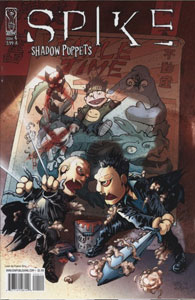On my first read of IDW’s “Spike” comics, my attitude was “Why are they introducing new characters instead of using the familiar group?” That’s the curse of new characters introduced into a comic book that continues a TV narrative. Without an actor to anchor them, they seem ephemeral. But the passage of time has changed my perspective, and I warmed up to Brian Lynch’s four-issue “Shadow Puppets” (June-October 2007) on this read.
Joining Spike in his fight against the kids’-show puppets in Japan – in “Smile Time” (“Angel” 5.14), they were merely driven out of the U.S. – is just one other TV character, Lorne. Fleshing out the team are Beck, the firestarter girl, and Betta George, the telepathic floating fish — both from Lynch’s “Asylum” – and Tok, a Japanese martial artist who has made it her mission to fight the supernatural.
I like all of them. Tok’s unsubtle crush on Spike is a particularly amusing through-line. As with “Asylum,” “Shadow Puppets” does less with Beck than I’d like; I do enjoy how she is inspired by Spike to be a hero, but the writing and Franco Urru’s art could do a better job of illustrating that she’s a teenager, in contrast to the adult Tok.
Lorne’s reason for joining Spike in Japan is mysterious until we get a shaky explanation: He was tired of being a freak, and thought he could escape that on this adventure. (If you look like Lorne, Vegas is obviously your place, not Japan.) Still, the Spike-Lorne riffing – starting with Lorne making fun of Spike’s British-isms – provides a lot of “Shadow Puppets’ ” momentum.
Most importantly, Lynch knows how to write Spike in amusing fashion without drifting from a moral through-line; in this case, Spike realizes he’s not built to be a loner, it’s just that he works best when he has his own team rather than being a barely tolerated sidekick.
Spike narrates his actions in a failed attempt to convince the listener of his heroism. For example:
“I even duck behind a hot dog cart when a car backfires to make sure there are no small children in peril.”
Then there are the puppets. Spike, Lorne and George get turned into puppets, as Angel does in “Smile Time,” and we get expected but humorous gags like Lorne accidentally ripping off Spike’s arm and Spike biting one of the evil puppets, resulting in a mouthful of stuffing instead of blood.
It gets really wild in the final issue, when doppelganger puppets of all the major “Angel” characters join the fray. Your mileage with Lynch’s meta-commentary may vary. For example, there are three Wesleys: one is the classic, timid Watcher; one is the seasoned fighter; and one is Spoiler Wesley, looking like he’s dying, as will later happen in “Not Fade Away” (5.22).
That tidbit – as well as Spike daydreaming about how Wesley would react to learning of Spike’s death-by-puppet — positions “Shadow Puppets” in Season 5, and it therefore puts its precursor, “Asylum,” in Season 5 as well. “Asylum” sometimes seemed like it was set after Season 5, so it’s nice to have things cleared up.

Lynch mostly maintains a humorous but fast-paced tone. He missteps during an Issue 3 subplot where the gang seeks information from a demon with a large brain. This demon makes them fight his mutant monkey sidekick for no apparent reason.
My small qualm about the ambiguous age of Beck notwithstanding, Urru’s work is excellent. The streets of Japan seem as fully populated as you’d expect, we get a good sense of how kids are in danger from the “Smile Time” puppets, and his puppet versions of everyone from Angelus to Illyria almost make me want to buy plush versions. (The real-world merchandizing doesn’t extend beyond a plush Angel.)
In addition to “Shadow Puppets” itself being a strong tale, it establishes Team Spike more firmly, and remarkably, it makes me want to follow Beck, Tok and Betta George into future stories.
Click here for an index of all of John’s “Buffy” and “Angel” reviews.

